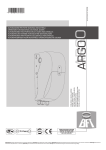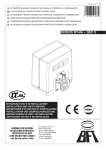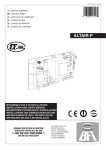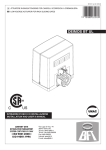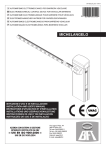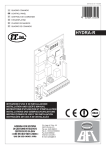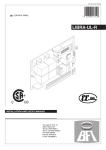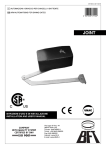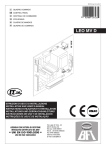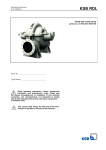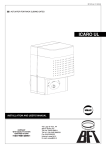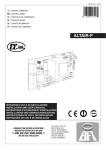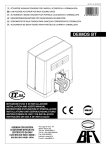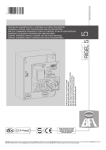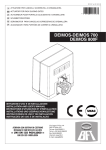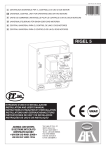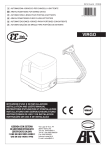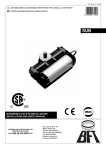Download DEIMOS BT UL - Ultra Access Controls
Transcript
D811419 ver. 07 05-06-07 I ATTUATORE IN BASSA TENSIONE PER CANCELLI SCORREVOLI A CREMAGLIERA GB LOW-VOLTAGE ACTUATOR FOR RACK SLIDING GATES 8 027908 231079 DEIMOS BT UL ISTRUZIONI D’USO E DI INSTALLAZIONE INSTALLATION AND USER’S MANUAL Via Lago di Vico, 44 36015 Schio (VI) Tel.naz. 0445 696511 Tel.int. +39 0445 696533 Fax 0445 696522 Internet: www.bft.it E-mail: [email protected] D811419_07 ENGLISH USER’S MANUAL Thank you for buying this product, our company is sure that you will be more than satisfied with the product’s performance. The product is supplied with a “Warnings” leaflet and an “Instruction booklet”. These should both be read carefully as they provide important information about safety, installation, operation and maintenance. This product complies with the recognised technical standards and safety regulations. 1) GENERAL OUTLINE The DEIMOS BT UL actuator offers ample installation versatility thanks to its compactness, the extremely low position of its pinion as well as the height and depth adjustments available. The adjustable electronic torque limiter ensures antisquash safety. The emergency manual manoeuvre can be activated very easily by means of a knob. The end-of-run stop is controlled by electromechanical limit microswitches. The control unit is incorporated. Before each manoeuvre, the control unit performs a check of the operation relays and safety devices (photocells, rubber skirt, etc.). The incorporated control panel checks the drive relays and safety devices (photocells and safety edge) before carrying out any manoeuvre. The following optional accessories are available: - SBBAT mod. Buffer battery kit It can be incorporated into the actuator, and allows the automation system to operate even when the mains power supply is disconnected for a short time. - MSC mod. Release knob (fig.2) Fixed release knob with personalised key. 2) SAFETY If correctly installed and used, this automation device satisfies the required safety level standards. However, it is advisable to observe some practical rules in order to avoid accidental problems. Before using the automation device, carefully read the operation instructions and keep them for future reference. • Keep children, persons and things outside the automation working area, particularly during operation. • Keep radio control or other control devices out of children’s reach, in order to avoid any unintentional automation activation. • Do not intentionally oppose the leaf movement. • Do not attempt to open the gate by hand, if the actuator has not been released by means of the appropriate release knob. • Do not modify the automation components. • In case of malfunction, disconnect the power supply, activate the emergency release to gain access to the actuator and request the assistance of a qualified technician (installer). • Before proceeding to any external cleaning operation, disconnect the mains powers supply and at least one of the battery pole, if fitted. • Keep the photocell optical components and luminous signal indication devices clean. Check that the safety devices (photocells) are not obscured by branches or shrubs. • For any direct assistance to the automation system, request the assistance of a qualified technician (installer). • Have qualified personnel check the automation system once a year. • Entrance is reserved for vehicles, provide a separate entrance for pedestrians. 3) MANUAL RELEASE The manual or emergency release is to be activated when a gate must be opened by hand, and in all cases where the automation system fails to operate or operates incorrectly. To carry out the emergency manoeuvre, proceed as follows: • Insert the standard key into its appropriate seat (fig. 1) and rotate it anticlockwise (90°), then rotate the release knob clockwise along its entire stroke. This way the pinion is made to idle, and therefore allows the gate to be opened by hand. Warning: Do not push the gate leaf hard, but rather help it along its entire stroke. • To reset motor-driven control, rotate the knob anticlockwise along its entire stroke, and then rotate the standard key clockwise until it is held tight. Keep the key in a safe place which is known to all the people concerned. In the case where the release knob is supplied with a personalised key (fig.2), proceed as follows: • Insert the personalised key into the lock, rotate the key anticlockwise by 90°. • Hold the release knob and rotate it clockwise (fig. 2) until it stops. This way the pinion is made to idle, and therefore allows the gate to be opened by hand. • Push the gate leaf by hand, helping it along its entire stroke. The key cannot be taken out of the lock until the knob is brought back to its initial position (motor-driven activation). • To reset motor-driven control, rotate the knob anticlockwise along its entire stroke, move the key back to its locking position; then take the key out and keep it in a safe place which is known to all the people concerned. 4) MAINTENANCE AND DEMOLITION The maintenance of the system should only be carried out by qualified personnel regularly. The materials making up the set and its packing must be disposed of according to the regulations in force. WARNINGS The installation of the two supplied placards is required in the area of the gate and in a location where they are clearly visible. (Fig.12). Correct controller operation is only ensured when the data contained in the present manual are observed.The company is not to be held responsible for any damage resulting from failure to observe the installation standards and the instructions contained in the present manual. The descriptions and illustrations contained in the present manual are not binding. The Company reserves the right to make any alterations deemed appropriate for the technical, manufacturing and commercial improvement of the product, while leaving the essential product features unchanged, at any time and without undertaking to update the present publication. Fig. 1 EN OP SE 1 2 O CL Fig. 2 N E OP MSC EN OP E OS CL E OS CL 2 1 DEIMOS BT UL Ver. 07 - INSTALLATION MANUAL Thank you for buying this product, our company is sure that you will be more than satisfied with the product’s performance. The product is supplied with a “Warnings” leaflet and an “Instruction booklet”. These should both be read carefully as they provide important information about safety, installation, operation and maintenance. This product complies with the recognised technical standards and safety regulations. 1) GENERAL SAFETY WARNING! An incorrect installation or improper use of the product can cause damage to persons, animals or things. • The “Warnings” leaflet and “Instruction booklet” supplied with this product should be read carefully as they provide important information about safety, installation, use and maintenance. • Scrap packing materials (plastic, cardboard, polystyrene etc) according to the provisions set out by current standards. Keep nylon or polystyrene bags out of children’s reach. • This product was exclusively designed and manufactured for the use specified in the present documentation. Any other use not specified in this documentation could damage the product and be dangerous. • The Company declines all responsibility for any consequences resulting from improper use of the product, or use which is different from that expected and specified in the present documentation. • Do not install the product in explosive atmosphere. • The Company declines all responsibility for any consequences resulting from failure to observe Good Technical Practice when constructing closing structures (door, gates etc.), as well as from any deformation which might occur during use. • Disconnect the electrical power supply before carrying out any work on the installation. Also disconnect any buffer batteries, if fitted. • Fit an omnipolar or magnetothermal switch on the mains power supply, having a contact opening distance equal to or greater than 3,5 mm. • Check that a differential switch with a 0.03A threshold is fitted just before the power supply mains. • Check that earthing is carried out correctly: connect all metal parts for closure (doors, gates etc.) and all system components provided with an earth terminal. • Fit all the safety devices (photocells, electric edges etc.) which are needed to protect the area from any danger caused by squashing, conveying and shearing. • Position at least one luminous signal indication device (blinker) where it can be easily seen, and fix a Warning sign to the structure. • The Company declines all responsibility with respect to the automation safety and correct operation when other manufacturers’ components are used. • Only use original parts for any maintenance or repair operation. • Do not modify the automation components, unless explicitly authorised by the company. • Instruct the product user about the control systems provided and the manual opening operation in case of emergency. • Do not allow persons or children to remain in the automation operation area. • Keep radio control or other control devices out of children’s reach, in order to avoid unintentional automation activation. • The user must avoid any attempt to carry out work or repair on the automation system, and always request the assistance of qualified personnel. • Anything which is not expressly provided for in the present instructions, is not allowed. • Installation must be carried out using the safety devices and controls prescribed by the EN 12978 Standard. 2) GENERAL OUTLINE The DEIMOS BT UL actuator offers ample installation versatility thanks to its compactness, the extremely low position of its pinion as well as the height and depth adjustments available. The adjustable electronic torque limiter ensures antisquash safety. The emergency manual manoeuvre can be activated very easily by means of a knob. The end-of-run stop is controlled by electromechanical limit microswitches. The control unit is incorporated. Before each manoeuvre, the control unit performs a check of the operation relays and safety devices (photocells, rubber skirt, etc.). The gearmotor (fig.1) comprises: The incorporated control panel checks the drive relays and safety devices (photocells and safety edge) before carrying out any manoeuvre. M Motor. R Reduction gear with worm screw and wheel. F Electromechanical limit switch unit. P Pinion. S Release mechanism. QSC-D UL Control panel The following optional accessories are available: - SBBAT mod. Buffer battery kit It can be incorporated into the actuator and allows the automation system 12 - DEIMOS BT UL Ver. 07 to operate even when the mains power supply is disconnected for a short time. The pack includes (fig.1): • 2 buffer batteries (ref. B). • 1 battery holder base (ref. BB). • 1 battery charger board (ref. SBS). • Assembly instruction manual. • Various bolts, screws and cables. - MSC mod. Release knob (fig.18) Fixed release knob with personalised key. • • • • • INSTALL THE GATE OPERATOR ONLY WHEN: The operator is appropriate for the construction of the gate and the usage Class of the gate, All exposed pinch points are eliminated or guarded, The operator is intended for installation only on gates used for vehicles. Pedestrians must supplied with a separate access opening, The gate must be installed in a location so that enough clearance is supplied between the gate and adjacent structures when opening and closing to reduce the risk of entrapment. Swinging gates shall not open into public access areas, The gate must be properly installed and work freely in both directions prior to the installation of the gate operator. Do not over-tighten the operator clutch or presure relief valve to compensate for a damaged gate. For gate openers with hold-to-run control: • The gate operator controls must be placed so that the user has full view of the gate area when the gate is moving, • A sign with the message “WARNING” must be positioned near the controls. The characters for the writing should be at least 6.4 mm high. The following statement should also be indicated: “Moving Gate Has the Potential of Inflicting Injury or Death - Do Not Start Gate Unless Path is Clear”. • An automatic closing device (such as a timer, loop sensor, or similare device) shall not be employed • No other activation device shall be connected. Controls must be far enough from the gate so that the user is prevented from coming in contact with the gate while operating the controls. controls intended to be used to reset an operator after 2 sequential activations of the entrapment protection device or devices must be located in the line-of-sight of the gate. Outdoor or easly accesible controls shall have a security feature to prevent unauthorized use. All warnings signs and placards must be installed where visible in the area of the gate. For gate operator provided with sensor for contact-free detection: • See instructions on the placement of non contact sensor for each type of application, • Care shall be exercised to reduce the risk of nuisance tripping, such as when a vheicle, trips the sensor while the gate is still moving. • One or more non-contact sensor shall be located where the risk of entrapment or obstruction exist, such as the perimeter reachable by a moving gate or barrier. For gate operator provided with contact detection (rubber edge or similar): • On or more contact sensor shall be located at the pinch point of a vehicular vertical pivot gate. • A hardwired contact sensor shall be located and its wiring arranged so that the communication between the sensor and the gate operator is not subjected to mechanical damage. • A wireless contact sensor such as one that transimts radio frequency (RF) signals the gate operator for entrapment protection functions shall be located where the transimission of the signals are not obscrtucted or impeded y building structure, natural landscaping or similar obstruction. A wireless contact sensor shall function under the intended end-use conditions. • • • IMPORTANT SAFETY INSTRUCTIONS WARNINGS: to reduce the risk of injury or death: • Read and follow all instructions. Never let children operate or play with gate control. Keep the remote control away from children. Always keep people and objects away from the gate. NO ONE SHOULD CROSS THE PATH OF THE MOVING GATE. All openings of a horizontal slide gate are guarded or screened from the bottom of the gate to a minimum of 4 feet (1.22 m) above the ground to D811419_07 ENGLISH D811419_07 INSTALLATION MANUAL • • • • • • prevent a 2-1/4 inch (57.2 mm) diameter sphere from passing through the openings anywhere in the gate, and in that portion of the adjacent fence that the gate covers in the open position. All exposed pinch points are eliminated or guarded, and guarding is supplied for sliding gates exposed rollers. Test the gate operator monthly. The gate MUST reverse on contact with a rigid object or stop when an object activates the non-contact sensors. If the gate operator is not functioning properly, have a qualified service technician adjust the motor torque setting or the limit of travel and retest the gate operator. Failure to retest and to have any necessary adjustments made to the gate operator so it functions properly can increase the risk of injury or death. Use the emergency release only when the gate is not moving. KEEP GATES PROPERLY MAINTAINED. Read the user’s manual. Have a qualified service person make repairs to gate hardware. The entrance is for vehicles only. Pedestrians must use a separate entrance. SAVE THESE INSTRUCTIONS. 3) TECHNICAL DATA 3.1) DEIMOS BT UL Actuator Power supply:........................................ single-phase 120V ±10% 60Hz (*) Motor:................................................................................................ 24Vdc Motor revolutions: .........................................................................3500min-1 Absorbed power:.................................................................................. 70W Max absorbed power:....................................... 0,5A (120V~) - 1A (110V~) Reduction ratio: .................................................................................... 1/44 Output revolutions:............................................................................ 79min-1 Pinion pitch:............................................................ 0,157” (4mm) (14 teeth) Leaf speed:........................................................................ 7,87”/s (0,2 m/s) Max leaf weight: . ............................................. 1102,3 lb (5000N) (≈500kg) Max torque:.................................................................... 14,747 lb ft (20Nm) Impact reaction:...................................................... Electronic torque limiter Lubrication:..................................................................... Permanent grease Manual manoeuvre:.............................................. Mechanical knob release No. manoeuvres in 24 hours:................................................................... 30 Control unit:............................................................................. incorporated Buffer batteries (optional):......................................... 2 batteries 12V 1.2Ah Environmental conditions:............................................ from -15°C to +40°C Degree of protection:............................................................................ IP24 Noise:............................................................................................. < 70dBA Controller weight:......................................................... 15,4 lb (7kg (≈70N)) Dimensions:................................................................................... See fig.2 Class of gate operator............................................................................. I, II (*) Special supply voltages on request. 3.2) QSC-D UL Control unit technical data (Fig.17) Supply to accessories:......................................................... 24V~ (180 mA) Ampere-stop setting:.............................................. on closing and opening Automatic closing time: . ....................................................... from 3 to 120s Working time:....................................................................................... 2 min Pedestrian opening time:................................................................. 5s fixed Reverse pause:............................................................................ approx. 1s Blinker connection:................................................................ 24V max 25W Fuses:.......................................................................................... See fig.17 Parameter and option setting:....................................................................... by means of keys or universal palmtop programmer Incorporated Rolling-Code radio receiver:................ frequency 433.92MHz Coded by means of :............................................... Rolling-Code Algorithm No. combinations:.......................................................................... 4 milliard Antenna impedance: . ..........................................................50Ohm (RG58) Max no. radio controls to be memorised:................................................. 64 3.3) Transmitter versions which can be used: all Rolling Code transmitters compatible with . 4) PRELIMINARY CHECKS Before proceeding to any installation work, check that the gate structure conforms to whatever is prescribed by the current standards, and in particular that: • The gate sliding track is linear and horizontal, and the wheels are suitable for supporting the gate weight. • The gate manual operation can be carried out smoothly along its entire run, and there is no excessive side slipping. • A correct play is provided between the upper guide and the gate to ensure regular noiseless movement. • The opening and closing gate stops are positioned. • The established position for gearmotor fixing allows the emergency elements checked do not meet the above requirements, proceed to carrying out the necessary corrective actions or replacements. ENGLISH WARNING: Remember that control devices are intended to facilitate gate operation, but can not solve problems due to any defects or deficiency resulting from failure to carry out correct installation or maintenance. Take the product out of its packing and inspect it for damage. Should it be damaged, contact your dealer. Remember to dispose of its components (cardboard, polystyrene, nylon, etc.) according to the current prescriptions. 5) BASE PLATE ANCHORING 5.1) Standard position • Dig a hole where the cement pad with the buried base plate log bolts is to be placed in order to fix the reduction gear unit (fig.3). If the sliding track is already there, digging must be partly carried out in the track foundation casting. This way, should the track foundation casting sag, the gearmotor base would also lower, thus maintaining the play between pinion and rack (approximately 0,039”-0,078” (1-2 mm). • Position the base plate according to the dimensions specified in fig.4. • The pinion symbol printed on the base plate must be visible and directed towards the gate. This also ensures the correct positioning of the raceways for electrical connections. • Let the flexible pipes containing electrical cables protrude from the base plate. • In order to keep the base plate in its correct position during installation, it may be useful to weld two iron flat bars under the track, and then weld the log bolts onto them (fig.3). • Make a concrete casting in such a way as to embody the base plate casting into that of the gate track. • Accurately check that: The positioning dimensions are correct. That the base plate is well levelled. That the 4 stud threads are well clear of cement. Let the casting harden. 5.2) Other positions The gearmotor can be positioned in different ways. As an example, fig.5 illustrates a particular type of installation. In the case where the gearmotor is not fixed on the level of the sliding track (Standard position), you must ensure that the gearmotor is tightly secured also in relation to the gate position, so as to maintain a correct play 0,039”-0,078” (1-2 mm) between rack and pinion. The current safety standards with respect to persons, animals and things must be strictly observed, and in particular risks of accidents due to squashing in the area of pinion-rack meshing, as well as other mechanical risks, must be carefully avoided. All the critical spots must be protected by safety devices in compliance with the current prescriptions. 6) GEARMOTOR FIXING When the casting has hardened, observe fig. 6 and proceed as follows: • Position an M10 nut on each of the tie rods, keeping a distance of at least 0,098” (25mm) from the base to allow the gearmotor to be lowered after the installation is completed, or for subsequent adjustments of the play between pinion and rack. • Position a plate “P” supplied as standard on each pair of tie rods and, with the help of a level, adjust the plane in both directions. • Remove the cover and screw-cover guard from the gearmotor, and position the reduction gear unit on the four tie rods with the pinion facing the gate. • Position the four washers and screw the four gearmotor locking bolts. • Adjust the depth of the gearmotor, making it slide in the appropriate slots found in the base, and fix it at a distance between pinion and gate which is adequate to the type of rack to be installed. The rack teeth must mesh into the pinion along their entire width. In the paragraph headed “Rack fitting” we specify the measurements and installation methods of the most widely used types of rack. 7) RACK FITTING A rack having a 4 tooth pitch must be fitted to the gate. As far as the length is concerned, this must include the passage space, as well as the space for securing the brackets activating the limit microswitches, and for the pinion meshing section. There are different types of rack, each one differing in terms of capacity and gate fixing method. The Company markets three types of racks, which are. 7.1) Mod. CFZ (Fig.8). Galvanised iron rack - 0,866”x0,866 (22x22mm) section - supplied in 2 - metre lengths - capacity over 4409,2 lb (2000kg (≈ 20000N)). First weld these pieces onto an adequate iron angle bar and then weld the lot to the gate. Besides maintaining the distance between the rack and the side of the gate, the angle bar makes it easy to fix the rack to the gate, even when the latter is subject to slight side slipping. When join welding the various rack pieces, you are advised to arrange a section of rack as in (fig.7) to ensure a correct pitch along the entire length of the rack. DEIMOS BT UL Ver. 07 - 13 INSTALLATION MANUAL 7.2) Mod. CPZ (Fig.8). Plastic rack - 22x22mm section - supplied in 3,28ft (1- metre) lengths - max. capacity 1102,3lb (500kg (≈ 5000N)). This model is to be fixed to the gate by means of normal or self-threading screws. Also in this case, you are advised to insert a section of rack the other way round in the joint between the various pieces, so as to maintain the correct tooth pitch. This type of rack is quieter and allows height adjustments to be made even after having been fixed, using the slots provided. 7.3) Mod. CVZ (Fig.8) Galvanised iron rack - 1,18x0,47“(30x12mm) section - supplied in 3,28ft (1 - metre) lengths - threaded spacers to be welded - max. capacity 4409,2 lb (2000kg (≈ 20000N)). Having fixed the spacers in the middle of each of the slots in the various rack pieces, weld the spacers to the gate. Also in this case, arrange a section of rack the other way round in the joining points of the various rack pieces to ensure a correct tooth pitch. The screws which fix the rack to the spacers allow the rack to be adjusted in height. 7.4) Rack fitting To fit the rack, proceed as follows: • Activate the emergency release by rotating the appropriate release knob (See paragraph “Emergency manoeuvre”). • Rest the rack end on the control pinion and secure it (by welding or using screws) in correspondence with the pinion, while sliding the gate along by hand (fig. 9). • In the case of incorrect gate alignment (excessive side curving) which cannot be corrected, place a few shims between the rack and gate in order to ensure continuous centring of the rack with respect to the pinion (fig. 10). DANGER - The welding operation is to be carried out by a competent person who must be provided with all the personal protection equipment required by the current safety standards. 8) PINION ADJUSTMENT Having finished fixing the rack, the rack-pinion play needs to be adjusted to approximately 0,078”(2mm) (fig.6): this is obtained by slackening the four M10 nuts under the gearmotor base by approximately 0,078”(2mm), and then securing the four upper nuts. Make sure that the rack and pinion are aligned and centred (fig.10). WARNING - Remember that the rack and pinion life strictly depends on their correct meshing. 9) ELECTROMECHANICAL LIMITING DEVICES The operation must be carried out with the emergency release activated and the mains power supply disconnected. The runners which control the limiting devices are to be positioned at both ends of the rack. - Push the gate fully open by hand. - Position the opening end-of-stroke runner (fig.11) so that it intercepts the microswitch control lever and makes it trigger. Having identified the correct position, tighten the runner screws. - Push the gate fully closed by hand. - Position the closing end-of-stroke runner (fig.11) so that it intercepts the microswitch control lever and makes it trigger. Having identified the correct position, tighten the runner screws. - The runners must lock the gate before this intercepts the mechanical backstops placed on the track.The closing end-of-stroke runner adjustment must be made in such a way as to leave a clearance of approximately 50mm between the gate and the fixed swing leaf, as prescribed by the current safety standards, otherwise fit an electric edge at least 50mm thick (fig.12). 10) GATE BACKSTOPS DANGER - The gate must be provided with mechanical backstops, both on opening and closing, in order prevent it from coming out of the upper guide (fig.13); the backstops must be tightly secured to the ground, a few centimetres beyond the electrical stop point. 11) ELECTRICAL INSTALLATION SETUP Lay out the electrical installation as shown in fig.14 with reference to the CEI 64-8 and IEC364 provisions complying with the HD384 and other national standards in force for electrical installation. WARNING! For connection to the mains, use a multipolar cable having a minimum cross section of 3x16 AWG and complying with the current standards. (For example, if the cable is not protected, it must be at least equal to H07 RN-F, whereas if it is protected it must be at least equal to H07 VV-F with a 3x16 AWG sq cross section). Connect the control and safety devices in compliance with the previously mentioned technical installation standards. The cables (mains and auxiliary) must be distinctly separated. Fig.14 shows the number of connections and 14 - DEIMOS BT UL Ver. 07 their cross sections for a length of approximately 328,08 ft(100 metres); for greater lengths, calculate the cross section for the true automation load. The main automation components are (fig.14): I Type-approved adequately rated omnipolar circuit-breaker with at least 0,14”(3,5 mm) contact opening, provided with protection against overloads and short circuits, suitable for cutting out automation from the mains. If not already install ed, place a type-approved omnipolar circuit-breaker with a 0.03A threshold just before the automation system. QR Control panel with built-in receiver S Key selector. AL Blinker with tuned antenna. M Actuator P Wall-mounted pushbutton panel. Fte, Fre Pair of external photocells. T 1-2-4 channel transmitter C Rack ANTENNA INSTALLATION Use an antenna tuned to 433MHz. For Antenna-Receiver connection, use RG8 coaxial cable. The presence of metallic masses next to the antenna can interfere with radio reception. In case of insufficient transmitter range, move the antenna to a more suitable position. 12) TERMINAL CONNECTIONS After adequate electric cables have been made to pass through the raceways and the various automation components fixed to the chosen points, these must be connected according to the instructions and diagrams shown in the relevant instruction manuals. Connect the phase, neutral and earth (compulsory) cables. The mains cable is to be secured in the appropriate cable clamp (fig.15- ref. P1), the accessory cables in their cable clamp (fig.15- ref. P2), and the protection (earth) wire, having a yellow/green insulating sheath, must be held in its appropriate wire clamp (fig.15 - ref. S). The automation device is to be set at work after all the safety devices have been connected and checked. See the terminal diagram in fig.16. JP2 1-2 Motor connection (1 Blue - 2 Red). 3-4 Transformer secondary circuit 24V. WARNING – If the opening direction is not correct, reverse connections 1 and 2 for the motor and connections 6 and 7 for opening and closing limit switches. JP3 5-6 Closing limit switch SWC (5 Black common - 6 Red) 5-7 Opening limit switch SWO (5 Black common - 7 Brown) 8-9 Blinker 24V max 25W. 10-11 Antenna (10 signal - 11 braid) 12-13 Power supply for accessories: 24 V~ operation with power supply on 24 V (12+,13-) operation with power supply off and optional battery back up. Mod. SB BAT 14-15 24 V~ output for acoustic signal (Fig. 19A). 16-17 Output for power supply to safety devices (photocell transmitter and safety edge transmitter) N.B.: output only active during the manoeuvre cycle 24 V~ operation with power supply on 24 V (16-,17+) operation with power supply off and optional battery back up. Mod. SB BAT. 18 Input for safety devices FAULT (see item 13). 19-20 Pedestrian control button PED (N.O.) Opens the gate for 5 seconds according to the logic set (3 or 4 steps). 21-22 START/CLOSE control button and key selector (N.O.). 21-23 STOP control button (N.C.). In all cases, stops the operator until the next Start command. If not used, leave bridged. 21-24 Input for photocell PHOT (see item 13). If not used, leave bridged. 21-25 BAR electric edge contact input (N.C.). In case of triggering, movement is stopped and reversed for about 3s. If not used, leave bridged. 21-26 OPEN control button (N.O.) JP1 31-32 Transformer primary circuit 120V~. 33-34 Single-phase power supply 120V~, 60Hz (33N - 34L). 13) CONNECTION TO SAFETY DEVICES Note: only use safety devices which can receive with a free changeover contact (refer to Fig.19). D811419_07 ENGLISH D811419_07 INSTALLATION MANUAL To connect the photocells refer to the diagram in fig. 19 taking into account the number of pairs used: 1 pair box 1C, 2 pairs box 2C. The control unit performs the test of 2 safety devices. The additional devices must be equipped with internal self-diagnosis and connected in series. If photocells are not used, leave the jumpers aligned between terminal 21/23, and between terminal 21/24 of the QSC D UL board. The connection of the infrared rubber skirt must be performed in the same way as for the photocells, i.e. by energizing the transmitter from terminal 16/17 and the receiver from terminal 12/13. 14) PROGRAMMING The control panel provided with a microprocessor is supplied with function parameters preset by the manufacturer, suitable for standard installations.The predefined parameters can be altered by means of either the incorporated display programmer or universal palmtop programmer. In the case where programming is carried out by means of universal palmtop programmer, carefully read the instructions relating to universal palmtop programmer, and proceed in the following way. Connect the universal palmtop programmer to the control unit through the UNIFLAT and UNIDA accessories (See fig. 17). The QSC-D UL control unit does not supply the universal palmtop programmer with power, and therefore requires an appropriate supply unit. Enter the “CONTROL UNITS” menu, and the “PARAMETERS” submenu, then scroll the display screenfuls using the up/down arrows to set the numerical values of the parameters listed below. For the function logics, refer to the “LOGIC” submenu. In the case where programming is carried out by means of the incorporated programmer, refer to Fig. A and B and to the paragraph on “Configuration”. N.B.: The QSC-D UL control unit cannot supply the universal palmtop programmer with power. 15) CONFIGURATION The display programmer is used to set all the QSC-D UL control panel functions. The programmer is provided with three pushbuttons for menu scrolling and function parameter configuration: + menu scrolling/value increment key - menu scrolling/value reduction key OK Enter (confirm) key The simultaneous pressure of the + and - keys is used to exit the active menu and move to the preceding menu. The modifications made are only set if the OK key is subsequently pressed. When the OK key is pressed for the first time, the programming mode is entered. The following pieces of information appear on the display at first: - Control unit software version. - Number of total manoeuvres carried out (the value is expressed in hundreds, therefore the display constantly shows 0000 during the first hundred manoeuvres). - Number of manoeuvres carried out since the latest maintenance operation (the value is expressed in hundreds, therefore the display constantly shows 0000 during the first hundred manoeuvres). - Number of memorised radio control devices. When the OK key is pressed during the initial presentation phase, the first menu can be accessed directly. Here follows a list of the main menus and the respective submenus available. The predefined parameter is shown between square brackets [ 0 ]. The writing appearing on the display is indicated between round brackets. Refer to Figures A and B for the configuration procedure. 15.1) Parameters menu - Automatic Closing Time (TCA) [ 10s ] Set the numerical value of the automatic closing time from 3 to 120 seconds. - Opening Motor torque (op. t) [ 80% ] Set the numerical value of the motor torque between 1% and 99%. - Closing Motor torque (cls. t) [ 80% ] Set the numerical value of the motor torque between 1% and 99%. - Slow-down opening motor torque (op. t slow) [ 50% ] (parameters ⇒ address 8) Set the numerical value of the motor torque between 1% and 99%. - Slow-down closing motor torque (cls. t slow) [ 50% ] (Advanced parameters ⇒ address 9) Set the numerical value of the motor torque between 1% and 99%. - Fast Opening Time (op. speed. time) [ 15 s. ] (Advanced parameters ⇒ address 6) Set the time ato normal opening speed (not slowed down), ranging from 1 second to 2 mins. - - - ENGLISH Fast Closing Time (cls. speed. time) [ 15 s. ] (Advanced parameters ⇒ address 7) Set the time to normal closing speed (not slowed down), ranging from 1 second to 2 mins. Note: The slow-down time, on closing and on opening, is obtained by timing one manoeuvre, and setting a lower value within this parameter. If, for example, one manoeuvre lasts 15 seconds, set “normal speed time” to 12s to obtain 3s of slow-down time. Slow-down speed (slov speed) [ 0 ] (Advanced parameters ⇒ address 5) Set the slow-down speed by choosing from one of the following values: 0 – slow down disabled 1 – slow down at 50% of normal speed 2 – slow down at 33% of normal speed 3 – slow down at 25% of normal speed Zone (zone) [ 0 ] (Advanced parameters ⇒ address 1) Set the zone number between a minimum value of 0 and a maximum value of 127. See paragraph on “Serial connection”. 15.2) MENU LOGIQUES (logic) - TCA (TCA) [ OFF ] ON Activates automatic closing OFF Excludes automatic closing - 3 Steps (3 step) [ OFF ] ON Enables 3-step logic. A Start impulse has the following effects: door closed: opens on opening: stops and enters TCA (if configured) door open: closes on closing: stops and reopens OFF Enables 4-step logic. A Start impulse has the following effects: door closed: opens on opening: stops and enters TCA (if configured) door open: closes on closing: stops and does not enter TCA (stop) after stopping: opens - Impulse lock (ibl open) [ OFF ] ON The Start impulse has no effect during the opening phase. OFF The Start impulse becomes effective during the opening or closing phase. - Photocells on opening (photc. open) [ OFF ] ON: In case of obscuring, this excludes photocell operation on opening. During the closing phase, it immediately reverses the motion. OFF: In case of obscuring, the photocells are active both on opening and on closing. When a photocell is obscured on closing, it reverses the motion only after the photocell is disengaged. - Photocell test (test phot) [ OFF ] (Advanced logics ⇒ address 14) ON Activates photocell check OFF Deactivates photocell check If this setting is not activated (OFF), it inhibits the photocell checking function, allowing connection of devices not provided with additional checking contact. - Prealarm (preal) [ OFF ] ON The blinker comes on about 3s before the motors start. OFF The blinker comes on at the same time as the motors start - Hold-to-run control (hold-to-run) [ OFF ] ON Hold-to-run operation: the manoeuvre continues as long as the control key is kept pressed.(OPEN-CLOSE) OFF Impulse operation, according to the 3 or 4 step logic. - Start-Close selection (start - close) [ OFF ] ON The input between the two terminals 21-22 acts as close OFF The input between the two terminals 21-22 acts as start Fixed code (fixed code) [ OFF ] (Advanced logics ⇒ address 13) ON The receiver is configured for operation in fixed-code mode, see paragraph on “Radio Transmitter Cloning”. OFF The receiver is configured for operation in rolling-code mode, see paragraph on “Radio Transmitter Cloning”. Radio transmitter programming (radio prog) [ ON ] (Advanced logics ⇒ address 15) ON This enables transmitter storage via radio: 1 – First press the hidden key (P1) and then the normal key (T1, T2, T3 or T4) of a transmitter already memorised in standard mode by means of the radio menu. 2 – Within 10s press the hidden key (P1) and the normal key (T1, T2, T3 or T4) of a transmitter to be memorised. The receiver exits the programming mode after 10s, other new transmitters can be entered before the end of this time. This mode does not require access to the control panel. DEIMOS BT UL Ver. 07 - 15 INSTALLATION MANUAL OFF This disables transmitter storage via radio. The transmitters can only be memorised using the appropriate Radio menu. - Loop (loop) [ OFF ] (Advanced logics - address 11) ON In the case of a closed loop centralised connection (Fig.20), set the control unit to ON. OFF In the case of an open centralised connection (Fig.20), set the control unit to OFF. - Master/Slave (Master) [ OFF ] (Advanced logics - address 12) ON The control panel is set as Master in a centralised connection. OFF The control panel is set as Slave in a centralised connection. 15.3) RADIO MENU (RADIO) Add Allows you to add one key of a radio control device to the receiver memory; after storage it displays a message showing the receiver number in the memory location (from 01 to 64). Add Start button (add start) associates the required key to Start command For transmitters with hidden key, press hidden key P1 (fig. B1). For transmitters without hidden key, the key P1 function corresponds to simultaneously pressing the 4 transmitter keys or, after opening the battery compartment, bridging the two P1 points by means of a screwdriver (fig. B2). Read (read) Checks one key of a receiver; if stored it displays a message showing the receiver number in the memory location (from 01 to 64), and the key number (T1, T2, T3 or T4). Eliminate list (erease 64) WARNING! Completely removes all memorised radio control devices from the receiver memory. Receiver code reading (RX code) This displays the code entered in the receiver. IMPORTANT NOTE: STICK THE adhesive KEY LABEL ON THE FIRST MEMORISED TRANSMITTER (MASTER). In the case of manual programming, the first transmitter assigns the RECEIVER KEY CODE; this code is necessary in order to carry out subsequent cloning of radio transmitters. The on-board Clonix incorporated receiver is provided with a number of advanced functions: • Cloning of master transmitter (rolling-code or fixed code) • Cloning by replacement of transmitters already inserted in the receiver • Management of transmitter database • Management of common receivers To use these advanced function, refer to the universal palmtop programmer instructions and the CLONIX programming guide, supplied with the universal palmtop programmer device. 15.4) LANGUAGE MENU (language) Allows you to set the language on the display programmer. - ITALIAN (ITA) - FRENCH (FRA) - ENGLISH (ENG) - SPANISH (ESP) 15.5) DEFAULT MENU (default) Restores the preset default values on the control unit. After restoring, a new autoset operation must be carried out. 15.6) DIAGNOSTICS AND MONITORING The display on the QSC-D UL panel shows some useful information, both during normal operation and in the case of malfunctions. Diagnostics: In the case of malfunctions, the display shows a message indicating which device needs to be checked: PED = Pedestrian input activation STRT = START input activation STOP = STOP input activation PHOT = PHOT input activation BAR = COST input activation FLT = FAULT input activation for checked photocells CLOS = CLOSE input activation OPEN = OPEN input activation SWO = Opening limit switch input activation SWC = Closing limit switch input activation TH = Activation of software thermal protection 16 - DEIMOS BT UL Ver. 07 In the case where an obstacle is found, the QSC-D UL panel stops the door and activates a reverse manoeuvre; at the same time the display shows the “AMP” message. Monitoring: During the opening and closing phases, the display shows four digits separated by a dot, for example 35.40. The digits are constantly updated during the manoeuvre, and represent the maximum torque reached by motor 1 (35) and the selected torque (40). These values allow the torque setting to be corrected. If the maximum torque value reached during the manoeuvre gets sensibly close to the value set in the parameter menu, malfunctions may occur in the future following wear or slight door deformation. It is therefore advisable to check the maximum torque reached during some of the manoeuvres carried out in the course of installation, and if necessary set a value about 15-20 percent points higher in the parameter menu. 15.7) AUTOSET MENU (autoset) Allows you to automatically set the Motor torque. WARNING! The autosetting operation is carried out from closing end-ofstroke devices. If Autoset is commanded in a different position an error message indicating “nsvc” will be displayed and the required manoeuvre will not take place. WARNING!! The autoset operation is only to be carried out after checking the exact leaf (opening/closing) movement, and correct limit-switch activation. Set the adequate slow-down speed: by pressing OK the message “.... .... ....” is displayed and the control unit commands an opening manoeuvre without slow-down, followed by a closing manoeuvre without slow-down during which the duration of the stroke is memorised. Then, the control unit commands a second opening manoeuvre with slow-down followed by a second closing manoeuvre with slow-down during which the minimum torque value necessary for the movement of the leaf is automatically set. Then the control unit sets a slow-down speed of 8 sec. If the stroke lasts less than 8 seconds, the control unit sets a slow-down time equal to half stroke. During this phase, it is important to avoid obscuring the photocells, as well as using the STRT, STOP, PED, CLOS or OPEN commands and the display. After this, if autosetting has been successfully completed, the control unit displays the “OK” message and, after pressing any key, returns to the Autoset menu. If, on the other hand, the control unit displays the “KO” message, it means that the autoset procedure has not been successfully completed; it is thus necessary to check the wear condition of the gate and the regular movement of the leaves before proceeding to a new autoset operation. WARNING! During the autoset phase, the obstacle detection function is not active, therefore the installer must control the automation movement and prevent persons and things from approaching or standing within the automation working range. In the case where buffer batteries are used, autosetting must be carried out with the control panel supplied by mains power voltage. WARNING: the torque values determined by autosetting refer to the slow-down speed determined by autosetting. When modifying the slow-down speed, the slow-down torque values must be modified as well so that activation of the safety device takes place according to the new speed set. Incorrect sensitivity setting can cause injuries to persons or animals, or damage to things. 16) SERIAL CONNECTION USING SCS1 BOARD (Fig.20). The QSC-D UL control panel allows several automation units to be connected in a centralised way by means of appropriate serial inputs and outputs (SCS1). This makes it possible to use one single command to open and close all the automation units connected. Following the diagram in Fig. 20, proceed to connecting all the QSC-D UL control panels, exclusively using a telephone-type line. Should a telephone cable with more than one pair be needed, it is indispensable to use wires from the same pair. The length of the telephone cable between one appliance and the next must not exceed 820,2ft (250 m). At this point, each of the QSC-D control panels must be appropriately configured, by setting a MASTER unit first of all, which will have control over all the others, to be necessarily set as SLAVE (see logic menu). Also set the Zone number (see parameter menu) between 0 and 127. The zone number allows you to create groups of automation units, each one answering to the Zone Master unit. Each zone can only be assigned one Master unit, the Master unit in zone 0 also controls the Slave units in the other zones. Loop closing of the serial connection (indicated by a dotted line in Fig.20) is only needed if you require to check the no. of the connected devices by means of universal palmtop programmer. 16.1) Opposite sliding leaves (Fig. 20A) Serial connection also provides centralized control of two opposite sliding gates (Fig. 20A). D811419_07 ENGLISH D811419_07 INSTALLATION MANUAL In this case, the Master M1 control board will perform closing and opening of Slave M2 control board simultaneously. In case of opposite sliding leaves, the M1 (master) control board and the M2 (slave) control board should bear the same area number without other devices being connected in such area. If the opening direction of one of the two motors is incorrect, invert the connection 1 and 2 of the motor as well as the connections 6 and 7 of the opening and closing limiting devices. The safety devices (photocells and sensing edges) should be connected according to the diagram in Fig. 20A. To connect checked safety devices, make reference to whatever is specified in previous paragraph 13. Carry out connections on the MASTER control unit and only bring the cable of terminal 24 to the SLAVE control unit. On the SLAVE control unit, the TEST PHOT switch must be left on OFF. The Start, Open, Close, push-buttons and the Timer contact should be normally connected to the M1 (master) control board. The pedestrian command is to be connected to the M2 panel (slave). The Stop command provides greater safety and is generated by a double contact NC push-button connected to both control boards as shown in Fig. 20A. NOTE: Disable the TCA function from the M2 (slave) panel. 17) Statistics Having connected the universal palmtop programmer to the control unit, enter the CONTROL UNIT / STATISTICS menu and scroll the screenful showing the statistical parameters: - Board microprocessor software version. - Number of cycles carried out. If motors are replaced, count the number of manoeuvres carried out up to that time. - Number of cycles carried out from the latest maintenance operation. It is automatically set to zero after each self-diagnosis or parameter writing. - Date of latest maintenance operation. To be updated manually from the appropriate menu “Update maintenance date”. - Installation description. 16 characters can be entered for installation identification. 18) ALARM SIGNAL The operator is provided with an alarm siren managed from the control panel. The alarm signal is set off in the case where the obstacle detection device (amperostop) is activated twice, without the leaf being brought to its fully opened or closed position. In the case of malfunctions, any alarm activation immediately stops all manoeuvres. The acoustic signal can be interrupted using the STOP button. In the case of alarm activation, proceed to the following checks: 1) Check that the gate has not met any obstacles. 2) Check that the sliding track is clean and free from any debris along the entire leaf stroke. 3) Check that the sliding wheels on the leaf are undamaged and correctly positioned along the track. 19) MANUAL RELEASE The manual or emergency release is to be activated when you have to open the gate by hand, and in any event of failed or incorrect operation of the automation system. To carry out the emergency manoeuvre, you have to: • Insert the release knob in its appropriate seat (fig.18) and rotate it clockwise along its entire travel. This way you set the pinion idling, thus allowing to gate to be opened by hand. Warning: Do not push the gate leaf hard, but help it along its entire stroke. • To reset motorised control, rotate the knob anticlockwise along its entire travel, remove the knob and leave it in a safe place which is known to all the persons concerned. In the case where a release knob with personalised key is fitted (fig.18), proceed as follows: • Insert the personalised key in the lock, and rotate the key anticlockwise. • Grip the release knob and rotate it clockwise (fig.18) until it stops. • Push the gate leaf by hand and help it along its entire travel. • The key cannot be removed from its lock until the knob is returned to its initial position (motorised activation). • To reset motorised control, rotate the knob anticlockwise along it entire travel and remove the key. • • • ENGLISH Check the opening and closing operations with the control devices in use. Check the standard and customised electronic functioning logic. The installation of the two supplied placards is required in the area of the gate and in a location where they are clearly visible. (Fig.12). 21) AUTOMATION OPERATION Since the automation can be remote-controlled by means of a remote control device or a start button, and so out of sight, the good working order of all the safety devices should be checked regularly. In the event of any anomalous functioning of the safety devices, consult a specialised technician immediately. Keep children at a safe distance from the automation operation area. 22) CONTROL The automation is used for the power-operated opening and closing of the gate. The control can be of a number of types (manual, remote-controlled, magnetic badge access control, etc.) depending on requirements and the characteristics of the installation. See the specific instructions for the various control systems. Users of the automation must be instructed about its control and operation. 23) MAINTENANCE Disconnect the power supply when carrying out any maintenance operations. • Clean the lenses of the photocells every so often. • Have a qualified person (installer) check correct motor torque setting. • In the event of any anomalous functioning which cannot be resolved, disconnect the power supply and contact a specialised technician (installer). Whilst the automation is out of order, activate the manual release to allow manual opening and closing. 24) SCRAPPING WARNING! This operation should only be carried out by qualified personnel. Materials must be disposed of in conformity with the current regulations. In case of scrapping, the automation devices do not entail any particular risks or danger. In case of materials to be recycled, these should be sorted out by type (electrical components, copper, aluminium, plastic etc.). 25) DISMANTLING WARNING! This operation should only be carried out by qualified personnel. When the automation system is disassembled to be reassembled on another site, proceed as follows: • Disconnect the power supply and the entire external electrical installation. • In the case where some of the components cannot be removed or are damaged, they must be replaced. WARNINGS Correct controller operation is only ensured when the data contained in the present manual are observed. The company is not to be held responsible for any damage resulting from failure to observe the installation standards and the instructions contained in the present manual. 20) AUTOMATION CHECK Before allowing the automation to be used normally, carry out the following procedure very carefully: • Check the correct functioning of all safety devices (limit microswitches, photocells, sensitive edges etc.). • Check that the thrust (anti-squash) force of the leaf is within the limits set by current regulations. • Check the manual opening command. DEIMOS BT UL Ver. 07 - 17 LEGENDA ACCESS TO MENUS +- Press the OK key OK [ ] $2 OK OQABSJ /ON /OFF Control unit software version No. total manoeuvres (in hundreds) No. manoeuvres since latest maintenance (in hundreds) No. radio control devices memorised OK - + OK Preset value .0% Parameter increment/reduction or ON/OFF commutation Simultaneously press the + and - keys. Simultaneous pressure of the + and – keys allows you to exit the active menu and return to the preceding menu; if this takes place at the main menu level, programming is exited and the display switched off. The modifications made are only confirmed if the OK key is subsequently pressed. Message: Programming in progress Message: KO! (value or function error) Press OK key (Enter/confirm) Menu scrolling (+ = preceding - = following) Message: “Wait” (enter value or function) +.P+ OK RA OK [ ] OK .P% OK [ ] OK .P% OK [] OK .P% OK [ ] OK .P% OK [ ] OK .P% OK [ ] OK .P% OK [ ] OK .P% OK [ ] OK .P% OK [ ] OK .P% - + +- -. 2 - + $',# !*1 2 - + MN RQJMU - + - + AJQ RQJMU - + LMPK MN QNCCB - + LMPK AJQ QNCCB - + QJMUQNCCB - + 8MLC +*M%'A OK RA PARAMETER MENU [M$$] ON OFF OK OK [M$$] ON OFF OK .P% OK [M$$] ON OFF OK .P% OK [M$$] ON OFF OK .P% OK [M$$] ON OFF OK .P% OK [M$$] ON OFF OK .P% OK [M$$] ON OFF OK .P% OK [M$$] ON OFF OK .P% OK [M$$] ON OFF OK .P% OK [ML ] ON OFF OK .P% OK [M$$] ON OFF OK .P% OK [M$$] ON OFF OK .P% OK .P% - + +- QRCN - + $',# G@JMNCL - + NFMRMAMNCL - + R#QR.FMR - + - + NPC?J - + FMJBRMPSL - + QR?PRAJMQC - + FOLLOWING MENUS FIG. B DGVCBAMBC - + P?BGMNPME - + *MM. - + +1R#P 18 - DEIMOS BT UL Ver. 07 TCA (automatic closing time) value expressed in seconds (default 10=10s, min 3=3s, max 120=120s) Opening Motor torque – value expressed in % (default 80%, min 1%, max 99%) Closing Motor torque – value expressed in % (default 80%, min 1%, max 99%) Slow-down opening motor torque – value expressed in % (default 50%, min 1%, max 99%) Slow-down closing motor torque – value expressed in % (default 50%, min 1%, max 99%) Fast opening time value expressed in seconds (default 15=15s, min 1=1s, max 2=2 min) Fast closing time value expressed in seconds (default 15=15s, min 1=1s, max 2=2 min) Slow-down numerical value (default 0, min 0, max 3) Zone numerical value (default min 0, max 127) D811419_07 Fig. A D811419_07 Fig. B 1 PRECEDING MENUS FIG. A - + 0"'- T1 T2 T1 T2 T4 T3 T1 T1 T2 T3 T4 T2 +/OK OK ""QR?PR #," Press P1 (pushbutton) on radio control device FGBBCL@SRRML Release P1 on radio control device BCQGPCB@SRRML R Press the required T (key) on radio control device – see Fig. B3 OK PCJC?QC Press the required T (key) on radio control device – see Fig. B3 - + 0#" - + OK #01# .0% - + - + +/OK !-"06 OK J?LES?EC ! OK '2 OK - + +/- $0 - + OK - + #,% OK - + "#$3*2 OK .0% OK CQN OK +/#," 3 2 P1 P1 +/- #," P1 - + $" OK OK RADIO MENU ADD - Allows you to add one key of a radio control device to the receiver memory; after storage it displays a message showing the receiver number in the memory location (from 01 to 64). Add Start button – associates the required key to Start command R E A D - C h e c k s o n e k e y o n a r e c e i v e r, i f s t o r e d i t displays a message showing the receiver number in the memory location (from 01 to 64), and the key number (T1, T2, T3 or T4). ERASE 64 WARNING! Completely removes all memorised radio control devices from the receiver memory. COD RX Displays the receiver code. Make reference to paragraph 11. AUTOSET MENU It automatically sets the motor torque. OK 32-QCR +/- OK OK WARNING! During the autoset phase, the obstacle detection function is not active, therefore the installer must control the automation movement and prevent persons and things from approaching or standing within the automation working range. #," DEIMOS BT UL Ver. 07 - 19 D811419_07 Fig. 1 B BB M 88 QSC-D 88 SBS F S P R Fig. 3 ) 8" m 0, 2m (2 6,2 4,6 ) mm 249 ) m 3m (4 7" 1, 60m m) m) 8m 1 " (1 " (1 1,9" (50 mm) Z1 Ø 4 (5 p 2, 6 m 2" m ) 4,8" (122 mm) 10,4" (265 mm) Fig. 2 " 5,1 (13 1m m) "( 9,8 Fig.4 Min. 2,9" (75mm) Min. 3,9" (100mm) (Z14) CENTRO PIGNONE - PIGNON CENTER AXI PIGNON - RITZELACHSE - CENTRO PINON 0,9" (25mm) 20 - DEIMOS Fig. 5 BT UL Ver. 07 D811419_07 Fig. 7 P >0,9" 1,9" (25mm) (50mm) >3,9" (100 mm) 0,07" 2mm Fig. 6 0,9" (25mm) Fig. 9 0,8" (22mm) 0,4"(12mm) 0,7"(20mm) 1,1" (28mm) CFZ 1,1" (30mm) 0,8" (22mm) 1,1"(30mm) Fig. 8 1,4"(37mm) 1,2" (32mm) CPZ CVZ Fig. 10 OK NO Fig. 12 WARNING Fig. 11 SX DX Do not let children walk or run under a closing door. Do not let children operate door operator controls. Always keep a closing door within sight. In the event a person is trapped under the door, push the control button or use the emergency relase. Min. 1,9" (50mm) DEIMOS BT UL Ver. 07 - 21 A 1 B 2 0V 3 24V~ SWC NC SWO NC 4 C 5 D 6 E 7 24V 25W Max 0,7" (20mm) ANT 12 (-) P I AW G 3x1 6AW 2x16 AWG 3x16 AWG 24 V~/ (V Safe) NO NO G 2x16 AWG RG58 3x16 AWG COM 19 PED 20 COM NC PHOT NC NC 21 22 23 24 BAR 25 OPEN 26 F 31 G 32 NO 24V~ 17 18 STOP Fig. 15 16 FAULT START NO CLOSE T 18 AWG= 1 mm2 16 AWG= 1,5 mm2 15 ALARM 24 V 230V~ N 33 L 34 JP1 Grigio-Grey-Gris-Grau-Gris-Cinzento Fte S 3x18 AWG Grigio-Grey-Gris-Grau-Gris-Cinzento QR M 14 (+) Fre 13 (+) (-) AL 16 9 11 24V~/ 3x 8 10 Fig. 14 G 8AW 4x1 JP3 COM C D811419_07 M JP2 Fig. 16 Fig. 13 P1 P2 S 22 - DEIMOS BT UL Ver. 07 D811419_07 Fig. 17 Programmatore palmare universale Universal palmtop programmer Programmateur de poche universel Universellen Palmtop-Programmierer Programador de bolsillo universal Programador palmar universal QSC-D UL OK UNIFLAT T 1 A 250V UNIDA JP4 T 1 A 250V UNIFLAT Contatti Contacts Contacts Kontakte Contactos Contatos Contatti Contacts Contacts Kontakte Contactos Contatos UNIFLAT UNITRC UNIFLAT UNIMITTO UNITRC Contatti Contacts Contacts Kontakte Contactos Contatos P1P1 T1 T1 2 T 3 T 4 T T2 Led P1 P1 P1 P1 UNIMITTO UNITRC 2 1 Contatti Contacts Contacts Kontakte Contactos Contatos 1 2 P1 3 4 3 4 DEIMOS BT UL Ver. 07 - 23 D811419_07 Fig. 18 EN OP EN OP SE O CL EN OP E OS CL 1 2 E OS CL MSC 1 2 Fig. 19 2-C 5 4 3 2 1 5 4 3 2 1 Tx 1 Rx 1 13 12 5 4 3 2 1 JP3 24V ~ PHOT 24V ~ 18 17 16 2 1 Tx 2 Rx 2 2 1 Tx 1 Rx 1 4-C 12 13 35 36 12 13 24 - DEIMOS 5 4 3 2 1 2 1 Rx 1 Tx 2 BT UL Ver. 07 12 13 21 18 37 12 13 5 4 3 2 1 2 1 Rx 3 Tx 3 16 17 35 36 12 13 4 3 2 1 5 4 3 2 1 2 1 Rx 1 17 Tx 1 2 1 Rx 2 16 Tx 2 16 17 38 39 37 12 13 5 21 18 40 12 13 5 4 3 2 1 4 3 2 1 2 1 Rx 3 17 Tx 4 16 17 COM NC 16 Tx 3 2 1 Rx 4 NO JP3 NC 35 36 37 38 39 40 COM 13 12 24V ~ VSafe 5 SCS1-MA NO 18 17 16 24V ~ 21 FAULT 24 COM NC 17 17 QSC-D 24 21 16 16 COM NO NC COM JP3 Tx 1 2 1 Rx 2 35 36 37 38 39 40 NO 5 4 3 2 1 24V ~ 24 21 13 12 24V ~ VSafe FAULT 18 17 16 COM 21 SCS1-MA PHOT QSC-D PHOT 21 2 1 3-C 24 24 13 12 24V ~ VSafe FAULT 14 15 18 17 16 COM PHOT 12 13 21 24V ~ VSafe JP3 24 FAULT 1-C COM A D811419_07 Fig. 20 QSC D UL RX2 RX1 TX1 RX2 RX1 TX2 TX1 RX2 RX1 TX2 SCS1 SCS1 TX2 TX1 SCS1 Max. 250m SCS1 Fig. 20A QSC D M1 (MASTER) 7 QSC D M2 (SLAVE) 35 36 37 38 21 22 23 24 25 26 6 7 21 22 23 24 25 26 RX1 RX2 NC CC2 SWC2 SWO2 CC1 NC NC NC PHOT NC 35 36 37 38 STOP SWC1 SWO1 NC NC TX1 TX2 6 Fig. 21 QSC D UL SCS1-MA 35 3 7 63 38 39 COM NC NO COM NO NC 35 36 37 38 39 40 40 SCS1-MA DEIMOS BT UL Ver. 07 - 25
















